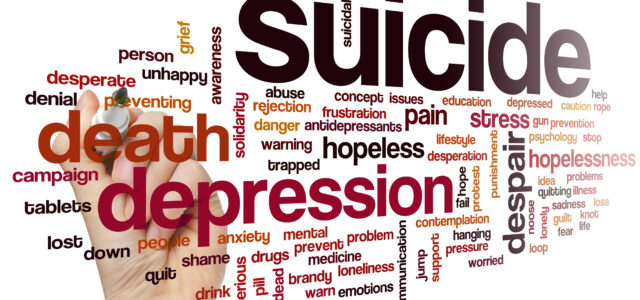
Bransfield’s colleagues from Howard University, Rush University Medical Center and the University of North Dakota agree with his assessment, stating, “We would like to applaud the author for conducting such an important study by performing a comprehensive assessment of suicide and its association with Lyme-associated diseases (LADs).” [2]

In their article “Suicidal and homicidal tendencies after Lyme disease: an ignored problem,” these three psychiatrists listed published case reports supporting Bransfield’s concerns:
• “A 44-year-old male without any past psychiatric history presented with a third unsuccessful suicide attempt and was later diagnosed as having Borrelia infection.” One month of medical therapy with intravenous ceftriaxone resulted in improvements in his mental status and resolution of suicidal ideation. [3]
• “Patients with Lyme borreliosis can experience psychiatric issues during both acute and late phases of the disease, most common being depression. In some cases, it slowly progresses to severity and suicidality … but in some cases, it is unpredictable.” [4]
• “[Two] patients were diagnosed with Lyme disease and appropriate treatment was offered. A few months after the treatment, both patients developed severe depression along with suicidal threats and an attempt by one patient. Evidence of persistent Lyme borreliosis was found in both cases.” [5]
In the third highlighted case, patient A was also suicidal, violent, and physically assaultive to her son. Patient B, who was followed over a span of 30 years, “was highly suicidal, had horrific intrusive images of killing others, and had violent impulses which were eliminated with treatment,” explains Bransfield. [2] Both patients recovered with antibiotic and psychotropic treatment, which “was clearly life saving.”
[bctt tweet=”An estimated 1200 suicides take place each year in the US due to Lyme and associated diseases. ” username=”DrDanielCameron”]
Bransfield raises several questions: [6]
- Why do only some patients with Lyme-associated diseases develop chronic symptoms, psychiatric symptoms, different types of psychiatric symptoms, suicidality, or homicidality?
- What is the exact pathophysiology and what are the most effective diagnostic and treatment approaches?
- How many patients are actually impacted by these conditions and to what extent?
Related Articles:
Suicidal behaviors in patients with Lyme and associated diseases
Lyme disease patients struggle with depression
References:
- Bransfield RC. Suicide and Lyme and associated diseases. Neuropsychiatr Dis Treat. 2017;13:1575-1587.
- Munir A, Aadil M, Rehan Khan A. Suicidal and homicidal tendencies after Lyme disease: an ignored problem. Neuropsychiatr Dis Treat. 2017;13:2069-2071.
- Banerjee R, Liu JJ, Minhas HM. Lyme neuroborreliosis presenting with alexithymia and suicide attempts. J Clin Psychiatry. 2013;74(10):981.
- Juchnowicz D, Rudnik I, Czernikiewicz A, Zajkowska J, Pancewicz SA. [Mental disorders in the course of lyme borreliosis and tick borne encephalitis]. Przegl Epidemiol. 2002;56 Suppl 1:37-50.
- Fallon BA, Schwartzberg M, Bransfield R, et al. Late-stage neuropsychiatric Lyme borreliosis. Differential diagnosis and treatment. Psychosomatics. 1995;36(3):295-300.
- Bransfield RC. Author’s reply. Neuropsychiatr Dis Treat. 2017;13:2071.



Thank you for speaking about Lyme Suicide. It is my mission to raise awareness and prevent this from happening. https://www.eventbrite.com/e/conference-on-neurological-tick-infections-mental-illness-suicide-prevention-tickets-35080930006?aff=es2
You have an outstanding faculty. The goal is great “This educational summit is a 1-1/2 day program for physicians and nurses on the diagnosis and treatment of neurological tick infections ( i.e.: Borellia Burdorferi, Bartonella etc.) which lead to cognitive impairments, mental illness and ideations of suicide/violence.”
This is very real. It haplened to me. I attempted suicide three times and almost succeeded twice. Doctors misdiagnosed and mistreated me. It was the most painful and scariest part of my life. I estimate I went undiagnosed for at least 7 years. I was losing my mind and my life and knew I was in a struggle for my life. I am one of the lucky who remember the tick bite and how things went downhill after it. I found a Lyme doctor and within a couple of month the depression was gone after taking antibiotics. It has taken longer for other symptoms to slowly get better but having the depression clear was the first step in having my life return to what it once was. Anyone older who is depressed and has never had depression before should be evaluated for a medical problem thag may be the cause of the depression. My depression was treatment resistant. That should have been a sign to the doctors.
If someone has Chronic Lyme disease and they begin to experience suicidal thought, should they go to their Lyme doctor or a psychiatrist for help?
It remains important to seek immediate help if you have suicidal thoughts. It is important to use of 911 or the emergency room if your doctor is not available. It also is important to consider an assessment for a tick borne illness as part of any evaluation.
I wish this article came out sooner. 5/1/17, my husband who we called Tommy tick, or Tommy tick magnet shot himself. He had been treated for Lyme’s disease. He was a hunter and woodsman. He loved the outdoors, but always managed to find a tick on him. After a beautiful trip to Aruba, we came home Saturday, and on Sunday his behavior was delusional. I did not know what to do, or what was wrong. That night, he shot himself. I truly believe his suicide was tick disease related. Please bring this to the forefront so that there is enough awareness.
Sorry to hear your loss.
My family adopted a stray cat when I was small & I got scratched then developed cat scratch fever from it. After three neurosurgeries for bartonella cysts, I attempted suicide twice. This was decades ago. It was a very dark time bc I didn’t have a diagnosis yet and my family didn’t understand the severity of suffering or how to offer any validation or support. As I was in my early 30s with few answers there was a lot of pressure to settle down marry and have kids but each time I got close the symptoms would push people away. Had numerous hospitalizations with no answers. My family came to think of me as a failure when I bounced from relationship to relationship unable to get traction with health family or career. Even though I worked my way up to top positions in journalism in Washington & Hollywood the disease always caused me to crash again and to lose everything. After surgeries left me with neuropathy the pain led me to seek pain meds or mmj. My family then labeled me an addict. This illness takes everything. Yet I wake up every day with hope to heal & be of service. It keeps me going. Sadly it’s now decades later and my family still feels terribly drained by this horrible illness (Lyme) & the poor politics and sad lack of support or awareness. StIll we press on in faith. Thanks for all you do to shed light Dr. Cameron.
Too late for me – I developed horrendous constant visual disturbances accompanied by an inexplicable feeling of horror and absolute dread for 2 years after contracting lyme disease. Even though I was one of the lucky few who received an NHS diagnosis, doctors still insisted my symptoms were psychosomatic and were on the verge of sectioning me under the mental health act. The thought of being institutionalised while suffering these horrendous symptoms and the accompanying neuropsychiatric anxiety and dread from my inflamed, infected brain pushed me over the edge and I made a last minute, panic-driven suicide attempt by jumping off a bridge. Amonth of ceftriaxone while I was in hospital with numerous broken bones restored my sanity, although I still battle with other aspects of the disease. The repercussions of feel as if they have destroyed my sense of self, well-being and body image to the point that my PTSD and distress is so great I cannot even try to treat the Lyme properly. I have had 6 years of constant trauma and despair since with no end in sight. I still cannot believe that a disease that was discovered as far back as the 60s has been so neglected, so weirdly politicised and still so poorly handled by medical authorities around the world. The amount ruined lives is staggering.